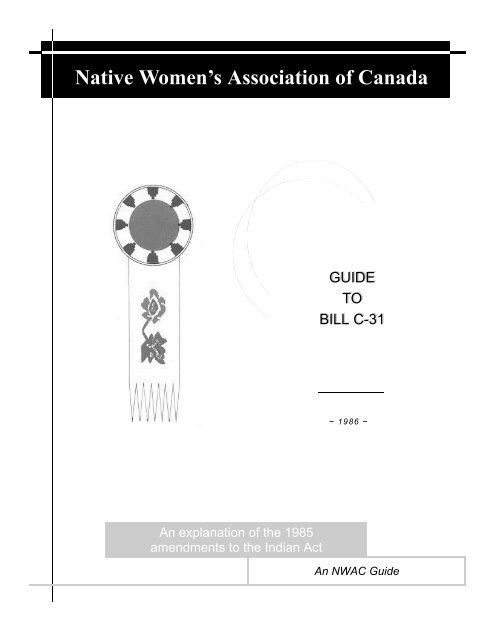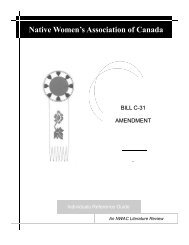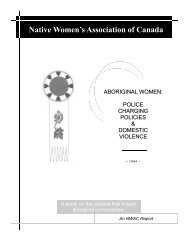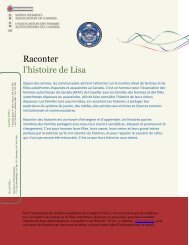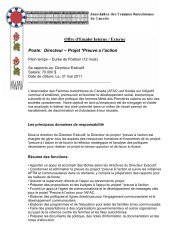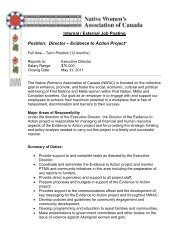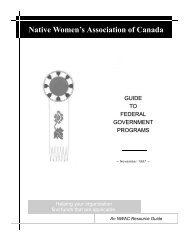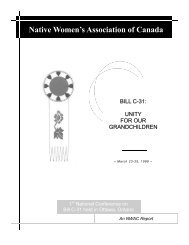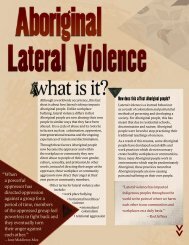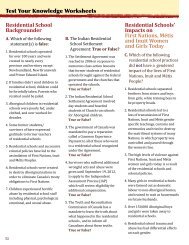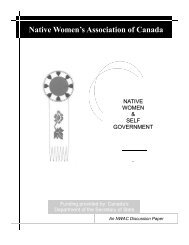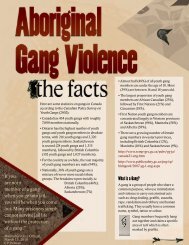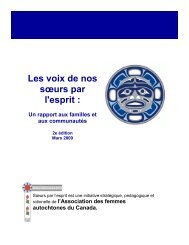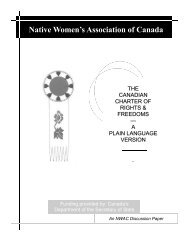Guide to Bill C-31 - Native Women's Association of Canada Website
Guide to Bill C-31 - Native Women's Association of Canada Website
Guide to Bill C-31 - Native Women's Association of Canada Website
- No tags were found...
You also want an ePaper? Increase the reach of your titles
YUMPU automatically turns print PDFs into web optimized ePapers that Google loves.
<strong>Native</strong> Women’s <strong>Association</strong> <strong>of</strong> <strong>Canada</strong>GUIDETOBILL C-<strong>31</strong>~ 1986 ~An explanation <strong>of</strong> the 1985amendments <strong>to</strong> the Indian ActAn NWAC <strong>Guide</strong>
Table <strong>of</strong> ContentsPreface.........................................................................................................3Introduction ..................................................................................................41. Who is Entitled <strong>to</strong> Federal Status........................................................6Section 6(1): ................................................................................................................6Section 6(2): ................................................................................................................8Summary <strong>of</strong> Major Effects <strong>of</strong> the New Status Provisions ............................................82. Who is not entitled <strong>to</strong> Federal Status................................................10Who is excluded from Registering.............................................................................10Who will not gain status Under <strong>Bill</strong> C-<strong>31</strong> ...................................................................12Second Generation Descendants ......................................................................................12Persons Who Took 'Scrip' ...................................................................................................14Women Who Gained Status by Marriage and Lost it......................................................143. Who is Entitled <strong>to</strong> Band Membership................................................18Those Entitled <strong>to</strong> be Entered in a Band List Maintained in the Department..............18Those with ‘Conditional’ Membership........................................................................204. Continuing Cases <strong>of</strong> Discrimination … .............................................23Unequal Transmission <strong>of</strong> Staus and Band Membership ...........................................23"Illegitimate” Children Treated Differently..................................................................235. Band Control <strong>of</strong> Membership ............................................................25Band Chooses <strong>to</strong> Control Membership: ....................................................................27Band Chooses not <strong>to</strong> Control Membership ...............................................................29Band Chooses <strong>to</strong> Return Control <strong>of</strong> Membership <strong>to</strong> the Department......................................<strong>31</strong>Notes on Entry <strong>to</strong> Band Lists and Transfers between Bands....................................<strong>31</strong>6. Protests and Appeal Mechanisms ....................................................33Federal Rules............................................................................................................33Band Rules................................................................................................................337. Other Amendments <strong>to</strong> Note ..............................................................35Residency Rights / Opting Out...............................................................................35Per Capita Shares and ‘Payback’ Mechanisms ........................................................35Discrimina<strong>to</strong>ry Provisions Deleted.............................................................................37Alcohol Control By-Laws ...........................................................................................37Creation <strong>of</strong> New Bands .............................................................................................37'Absolute Immunity’ Clause .......................................................................................39Report and Parliamentary Review.............................................................................398. Application for Status & Band Membership ......................................41Pg. 2
PREFACEThis is designed <strong>to</strong> be a guide <strong>to</strong> understanding the major amendments <strong>to</strong> the Indian Act as aresult <strong>of</strong> <strong>Bill</strong> C-<strong>31</strong>. It is therefore not intended <strong>to</strong> describe all <strong>of</strong> the changes made. Instead nontechnicallanguage and practical examples have been used as much as possible <strong>to</strong> assist thereader in gaining a good understanding <strong>of</strong> those provisions which have the greatest impact onour members and their families.It should be noted that because we are dealing with a law that is still foreign <strong>to</strong> our Nations, weare forced <strong>to</strong> use its terms in our document. Whenever we are making reference <strong>to</strong> the IndianAct and <strong>Bill</strong> C-<strong>31</strong>, we use terms like "Indian" and "non-Indian". Although these do notnecessarily accurately describe the ancestry <strong>of</strong> the individual concerned, it is recognized that"Indian" is a term introduced by the Europeans and not the First Nations.The new Act does not deal with Treaty Rights since these rights are not dependent upon federalstatus legislation. It is also important <strong>to</strong> note that although Aboriginal people in the westernprovinces use the term "Treaty Indian" <strong>to</strong> refer <strong>to</strong> status Indians, there are important legaldifferences between these two terms. Therefore we have used the term "status Indian"throughout.Throughout this booklet, we have used the terms -- "pre-1985" Act or "old" Act, <strong>to</strong> refer <strong>to</strong> theIndian Act before the amendments made <strong>to</strong> it by <strong>Bill</strong> C-<strong>31</strong>, and "new" Act or "new" sections, <strong>to</strong>refer <strong>to</strong> the legal provisions added <strong>to</strong> the Indian Act by <strong>Bill</strong> C-<strong>31</strong>.For the convenience <strong>of</strong> the reader, and in order <strong>to</strong> assist in the understanding <strong>of</strong> the <strong>Bill</strong>, therelevant provisions <strong>of</strong> the <strong>Bill</strong> and <strong>of</strong> the pre-1985 Indian Act have been reproduced on pagesfacing the commentary.Pg. 3
INTRODUCTIONOn April 17, 1985, section 15, the equality rights section <strong>of</strong> the Canadian Charter <strong>of</strong> Rights andFreedoms came in<strong>to</strong> force. In order <strong>to</strong> bring the Indian Act in<strong>to</strong> accord with this section,amendments had <strong>to</strong> be made <strong>to</strong> it.<strong>Bill</strong> C-<strong>31</strong>, entitled An Act <strong>to</strong> Amend the Indian Act, was tabled in the House <strong>of</strong> Commons onFebruary 28, 1985. It was then sent <strong>to</strong> the Standing Committee on Indian Affairs and NorthernDevelopment. After about 5 weeks <strong>of</strong> hearings on the <strong>Bill</strong>, the Standing Committee made anumber <strong>of</strong> amendments <strong>to</strong> the <strong>Bill</strong>. When the <strong>Bill</strong> reached the House, further changes weremade. It was finally passed on June 12, 1985. The Senate made no other changes <strong>to</strong> the <strong>Bill</strong>and it was given Royal Assent on June 28, 1985.The Minister <strong>of</strong> Indian Affairs and Northern Development, David Crombie insisted on threemajor principles being reflected in <strong>Bill</strong> C-<strong>31</strong>: elimination <strong>of</strong> discrimination from the Indian Act,reinstatement <strong>of</strong> individuals who once had status and band membership and band control <strong>of</strong>membership. In order <strong>to</strong> accommodate these principles, a number <strong>of</strong> changes have been made<strong>to</strong> the Indian Act, through <strong>Bill</strong> C-<strong>31</strong>.The sexually discrimina<strong>to</strong>ry sections <strong>of</strong> the Indian Act have been removed, as <strong>of</strong> April 17, 1985.Those who once had status and membership can now have it res<strong>to</strong>red and those who areeligible for first-time registration <strong>of</strong> status can be recognized. In both cases, it is up <strong>to</strong> theindividual <strong>to</strong> make an application <strong>to</strong> the Department, since the Government has stated that it willnot au<strong>to</strong>matically register individuals.In order <strong>to</strong> recognize the principle <strong>of</strong> band control <strong>of</strong> membership, the Government has chosen<strong>to</strong> separate the concepts <strong>of</strong> status and membership. The Federal Government will continue <strong>to</strong>confer status; bands will determine membership.Other changes have been made <strong>to</strong> the Indian Act through <strong>Bill</strong> C-<strong>31</strong>. The definitions <strong>of</strong> “elec<strong>to</strong>r”and "child" have been changed, the concept <strong>of</strong> enfranchisement has been abolished, and as <strong>of</strong>December 28, 1985 bands now have the by-law making powers <strong>to</strong> control alcohol on reserves.In addition, major decisions around control <strong>of</strong> membership and alcohol by-laws require theconsent <strong>of</strong> a majority <strong>of</strong> elec<strong>to</strong>rs.On June 28, 1987, the Minister <strong>of</strong> Indian Affairs and Northern Development will present <strong>to</strong>Parliament, a report which will assess the impact <strong>of</strong> <strong>Bill</strong> C-<strong>31</strong>.These and other areas are covered as thoroughly, and as simply, as possible in the followingpages.Pg. 4
Pg. 5
1. WHO IS ENTITLED TO FEDERAL STATUSIndian status is considered by the Federal Government <strong>to</strong> be a definition <strong>of</strong> its specialrelationship with Indians. The Federal Government also maintains that Parliament isresponsible for determining which individuals are status Indians. This is done throughthe provisions <strong>of</strong> the Indian Act, which are administered by the Department <strong>of</strong> Indian andNorthern Affairs. (DINA)In the old Act, status usually also meant band membership. It must be emphasized that<strong>Bill</strong> C-<strong>31</strong> now separates the two. Therefore bands are now recognized <strong>to</strong> have the right<strong>to</strong> determine band membership and can exercise this right if they so wish.Old sections 11 and 12 <strong>of</strong> the Indian Act dealing with status and band membership havebeen repealed. In the new Act status and membership are now dealt with in twoseparate areas.The discussion <strong>to</strong> follow describes the new status provisions contained in the newsection 6.Sub-sections 6(1) and 6(2) define who is entitled <strong>to</strong> be registered as a status Indian inthe Indian register maintained by the Indian Registrar at DINA.SECTION 6(1):a) All those already registered (whether entitled or not) in the Indian register as<strong>of</strong> April 16, 1985,andAll those entitled by law <strong>to</strong> be registered as <strong>of</strong> that date;b) All members <strong>of</strong> bands newly created or recognized by the Government, e.g.,the Conne River MicMac Band in Newfoundland;c) All persons who lost status through:- Section 12(1)(a)(iv) - the Double-Mother Clause- Section 12(1)(b) - Marriage <strong>to</strong> a non-Indian*- Section 12(2) - Children born out <strong>of</strong> marriage <strong>to</strong> an Indian woman and anon-Indian man and who lost status upon protest- Section 12(1)(a)(iii) and section 109(2) - an Indian woman involuntarilyenfranchised upon marriage <strong>to</strong> a non-Indianandany or all <strong>of</strong> her children from a former union who were involuntarilyenfranchised due <strong>to</strong> that marriage;*Note:"Non-lndian" includes those people who were denied entitlement under the pre- 1985 Act,even though they may have been <strong>of</strong> First Nations ancestry.Pg. 6
Pg. 7
d) All persons enfranchised under section 12(1)(a)(iii) and section 109 (1) - theenfranchisement <strong>of</strong> an Indian man along with his wife and unmarried childrendue <strong>to</strong> his so called 'voluntary' enfranchisement;e) Anyone enfranchised under:- Section 13 <strong>of</strong> the Indian Act 1927 (first introduced in 1880 and repealed in1951) - residency outside <strong>of</strong> <strong>Canada</strong> for more than 5 years without theconsent <strong>of</strong> the superintendent or Indian agent- Section 111 <strong>of</strong> the Indian Act 1906, (first introduced in 1867 and repealedin 1920) - upon becoming a lawyer, doc<strong>to</strong>r, clergyman, or upon receivingany degree from a university;(f) Children both <strong>of</strong> whose parents are entitled <strong>to</strong> be registered under any subsection<strong>of</strong> section 6, whether or not their parents are aliveSECTION 6(2):Children only one <strong>of</strong> whose parents is entitled <strong>to</strong> be registered under section6(1)(a) <strong>to</strong> (f).SUMMARY OF MAJOR EFFECTS OF THE NEW STATUS PROVISIONS1. No one gains or loses status through marriage.2. Persons who previously lost status through sexual discrimination andenfranchisement are entitled <strong>to</strong> regain status.3. First-time registration <strong>of</strong> children whose parents lost status is now possible.4. No one will have status unless at least one parent has, or would have had,status.5. The concept <strong>of</strong> enfranchisement is now entirely abolished; no one can renounceor lose status.Pg. 8
Pg. 9
2. WHO IS NOT ENTITLED TO FEDERAL STATUSWHO IS EXCLUDED FROM REGISTERINGWhen drafting <strong>Bill</strong> C-<strong>31</strong>, the Government decided not <strong>to</strong> have a long list detailing whowould not be entitled <strong>to</strong> Indian status, as was the case with the old Act. Instead, section6 contains all the categories <strong>of</strong> people entitled <strong>to</strong> be registered as status Indians.However one exception was made.The new section 7(1)(a) and 7(1)(b) bars two categories <strong>of</strong> persons from registering:Section 7(1)(a) Non-lndian women who gained status through marriage under old section 11 (1)(f)and then lost it for any reason.Example: A white woman marries an Indian and gains status. Later she divorcesthe Indian and marries a white man. She will not be able <strong>to</strong> regain status whichwas lost under old section 12(1)(b).(b) Children <strong>of</strong> such women whose fathers are also non-lndian.Example: A white woman who had gained status through marriage divorces herIndian husband. She has a child with her common-law husband who is alsowhite. That child is not entitled <strong>to</strong> be registered.Exception:In order <strong>to</strong> protect women and their children who had or were entitled <strong>to</strong> status at birth,from the exclusion under 7(1)' new sections 7(2) and (3) have been added:Section 7(2):This states that a woman will not be barred from registering as a status Indian if she hador was entitled <strong>to</strong> status at birth.Section 7(3):This applies <strong>to</strong> children <strong>of</strong> women described above. They will be entitled <strong>to</strong> register iftheir mothers had or were entitled <strong>to</strong> status at birth.Pg. 10
Pg. 11
WHO WILL NOT GAIN STATUS UNDER BILL C-<strong>31</strong>Despite what may be thought, not all people <strong>of</strong> First Nations ancestry will regain thestatus they lost, or the rights they were denied. Three major categories <strong>of</strong> aboriginalpeople are still not covered by the <strong>Bill</strong>:Second Generation DescendantsThe <strong>Bill</strong> covers reinstatement <strong>of</strong> those who lost status through the discrimina<strong>to</strong>ryprovisions or the enfranchisement provisions <strong>of</strong> the old Act. Their children, referred <strong>to</strong> asthe first generation, will also gain status. However, the Government decided <strong>to</strong> cutreinstatement <strong>of</strong>f at the second-generation level.The Act now imposes a new rule for all second-generation descendants. In order for thatchild <strong>to</strong> have status, both parents must be status under section 6(1) or (2) or at least oneparent must be status under section 6(1).Example: If only one parent has status under section 6(1), the first-generation child willhave status under section 6(2). If that child marries another status Indian, their children(second generation) will have status under section 6(1)(f). On the other hand if the firstgenerationchild has a non-Indian spouse, their children will not be registered.Illustration:Pg. 12
Pg. 13
Persons Who Took 'Scrip'Persons who received or were allotted 'half-breed lands or money script’, were excludedfrom status under old section 12(1)(a), as were their descendants. While C-<strong>31</strong> hasrepealed this section, it did not specifically reinstate these persons. To gain status, theymust qualify under one <strong>of</strong> the categories <strong>of</strong> new section 6.Women Who Gained Status by Marriage and Lost itAs previously stated, section 7(1)(a) prevents women, who gained status throughmarriage and then lost it through remarriage from regaining status. Although thiswill bar non-Indian women from being reinstated, it will also affect women <strong>of</strong> FirstNations ancestry who may not otherwise be entitled <strong>to</strong> status under the new bill.Example: A woman <strong>of</strong> First Nations ancestry gains status upon marriage <strong>to</strong> anIndian, then loses it upon remarriage <strong>to</strong> a non-Indian. If she did not have status atbirth, she will not regain status.Pg. 14
Pg. 15
Pg. 16
Pg. 17
3. WHO IS ENTITLED TO BAND MEMBERSHIPAs mentioned earlier in the discussion around status provisions, bandmembership is now separate from status. Just as status no longer necessarilymeans band membership, nor does band membership necessarily mean status.As a result <strong>of</strong> <strong>Bill</strong> C-<strong>31</strong>, bands can now determine who their members are if theyso wish. The new Act outlines procedures <strong>to</strong> be followed in these cases. <strong>Bill</strong> C-<strong>31</strong>also provides section 11 which defines band membership for those bands whochoose not <strong>to</strong> control their membership.Section 11(1) lists the categories <strong>of</strong> persons who are eligible for band membership as <strong>of</strong>April 17, 1985. Section 11(2) covers what we are referring <strong>to</strong> as 'conditional'membership.THOSE ENTITLED TO BE ENTERED IN A BAND LIST MAINTAINED IN THEDEPARTMENT.Section 11(1):a) Persons who were on the band list, or were entitled <strong>to</strong> be on the list, immediatelybefore April 17, 1985;b) Persons who are members <strong>of</strong> new bands;c) Persons who regain status under section 6(1)(c) <strong>of</strong> the new <strong>Bill</strong>:- Section 12(1)(a)(iv) - the Double-Mother clause- Section 12(1)(b) -Marriage <strong>to</strong> a non-Indian- Section 12(2) -Children born out <strong>of</strong> marriage <strong>to</strong> an Indian woman and a non-Indian man and who lost status upon protest- Section 12(1)(a)(iii) and Section 109(2) - an Indian woman involuntarilyenfranchised upon marriage <strong>to</strong> a non-Indianandany or all <strong>of</strong> her children from a former union who were involuntarily enfranchiseddue <strong>to</strong> that marriage;d) Children born after April 171 1985 both <strong>of</strong> whose parents are members <strong>of</strong> thesame band.Pg. 18
Pg. 19
THOSE WITH ‘CONDITIONAL’ MEMBERSHIPOn June 28, 1987, or earlier, if a band decides not <strong>to</strong> control its own membership threecategories <strong>of</strong> persons are au<strong>to</strong>matically entitled <strong>to</strong> membership.Unlike persons who are immediately entitled <strong>to</strong> membership under section 11 (1) above,those who have 'conditional' membership under section 11 (2), wait up <strong>to</strong> two years.Once this delay has passed, or if the band decides not <strong>to</strong> control its own membership,their names will be entered in the band list maintained by the Department.The three categories <strong>of</strong> persons affected are included in section 11 (2):Section 11(2):a) Anyone who was enfranchised under- old section 12(1 )(a)(iii) pursuant <strong>to</strong> old section 109(1 )- section 13 <strong>of</strong> the pre-1951 Indian Act- section 111 <strong>of</strong> the pre-1920 Indian Act;b) A child whose parents belong <strong>to</strong> different bandsorA child only one <strong>of</strong> whose parents is, or was, entitled <strong>to</strong> be a member <strong>of</strong> a band.It is important <strong>to</strong> note that a band that takes control <strong>of</strong> membership can either include orexclude all those 'conditionally' entitled. Again though, it is important <strong>to</strong> keep in mindwhen the band assumes control. If this is before June 28, 1987, the band can validlyexclude all the conditionally entitled. After June 28, 1987, the band may not excludeanyone who, immediately before that date, was entitled <strong>to</strong> band membership undersubsections (1) and (2) <strong>of</strong> section 11. This will be more fully explained in the followingpages.Pg. 20
Pg. 21
Pg. 22
4. CONTINUING CASES OF DISCRIMINATION RESPECTINGSTATUS AND BAND MEMBERSHIPWhile the new law has done away with the sexually discrimina<strong>to</strong>ry sections <strong>of</strong> the IndianAct for the future, the effects <strong>of</strong> past discrimination will still have an impact for the future.There are two major areas <strong>of</strong> continuing discrimination:UNEQUAL TRANSMISSION OF STATUS AND BAND MEMBERSHIPUnder <strong>Bill</strong> C-<strong>31</strong>, reinstated persons are treated differently than those already registeredas band members, when it comes <strong>to</strong> transmitting status and band membership <strong>to</strong> theirchildren and future generations.The child with only one reinstated parent is eligible for status only; band membership is'conditional'. On the other hand, the child <strong>of</strong> two parents who are already registered asband members, is entitled <strong>to</strong> both status and band membership, immediately.Example: A brother and sister who were both status each married non-Indians beforeApril 17, 1985. The brother's wife gained status, so their children are status and bandmembers. Not so for the sister who married a non-Indian. Under <strong>Bill</strong> C-<strong>31</strong>, she willregain status and band membership, but her children are entitled <strong>to</strong> less. They cangain status only and have 'conditional' band membership.Note: As indicated in this example, <strong>Bill</strong> C-<strong>31</strong> does not affect the rights <strong>of</strong> the non-Indianwoman who gained status upon marriage. It is important <strong>to</strong> note that Government isintent on respecting the 'acquired rights' <strong>of</strong> the non-Indian spouse. Parliamentarians aresimply not willing <strong>to</strong> alienate the nation-wide women's vote."ILLEGITIMATE" CHILDREN TREATED DIFFERENTLYIn 1983, the Supreme Court <strong>of</strong> <strong>Canada</strong> ruled in the case <strong>of</strong> MARTIN vs. CHAPMAN, thatthe "illegitimate" male child <strong>of</strong> a status male parent and a non-status female parentwould have status and membership, under old section 11(1)(c). However, the"illegitimate" female child was not entitled <strong>to</strong> be registered.This sub-section has been repealed under <strong>Bill</strong> C-<strong>31</strong>, but its legal effects still persist. Theseparation <strong>of</strong> status and band membership in the new Act means that the female child isstill treated differently.If a male child had status under old section 11, he will be registered under new section6(1) and therefore has an au<strong>to</strong>matic entitlement <strong>to</strong> band membership. His sister,however, will now gain status, but under new section 6(2). She will therefore have only a'conditional' entitlement <strong>to</strong> band membership.Pg. 23
Pg. 24
5. BAND CONTROL OF MEMBERSHIPAs has been stated earlier, while the Federal Government will maintain its policy <strong>of</strong>conferring status <strong>to</strong> Indians, it has decided <strong>to</strong> recognize the principle <strong>of</strong> band control <strong>of</strong>membership in <strong>Bill</strong> C-<strong>31</strong>. It is emphasized again that status and band membership areseparate elements, therefore individuals who may be recognized as members <strong>of</strong> a bandaccording <strong>to</strong> the band's own rules will not necessarily be status Indians as well.In order <strong>to</strong> accommodate the diversity amongst bands across the country, the <strong>Bill</strong>contains provisions which not only outline the requirements and process whereby a bandmay assume control <strong>of</strong> its membership, but also allows for situations where bands maydecide not <strong>to</strong> assume its own membership rules. As well, other provisions are available<strong>to</strong> deal with bands, who once having controlled membership, decide <strong>to</strong> return this control<strong>to</strong> the Department.Further <strong>to</strong> previous discussions around 'conditional' membership, it is important <strong>to</strong>remember that a band's decision <strong>to</strong> control or not control membership, as mentionedabove, and the timeliness <strong>of</strong> that decision will have different effects on those people whoare now status Indians, but whose membership is dependent on the band.While for the most part, the Federal Government intends <strong>to</strong> respect the decisions madeby the bands in determining and controlling membership, <strong>Bill</strong> C-<strong>31</strong> does call for somefundamental principles <strong>to</strong> be met: the 'acquired rights' <strong>of</strong> individuals must be protected,equality between sexes must be maintained, and a majority <strong>of</strong> elec<strong>to</strong>rs must giveconsent <strong>to</strong> band decisions regarding membership.There are many variables and complexities involved in the whole matter <strong>of</strong> band control<strong>of</strong> membership under <strong>Bill</strong> C-<strong>31</strong>. These are dealt with in the following sections <strong>of</strong> the<strong>Guide</strong>.Pg. 25
Pg. 26
BAND CHOOSES TO CONTROL MEMBERSHIP:Process:The new section 10 outlines the procedures <strong>to</strong> be followed by a band wishing <strong>to</strong> controlits membership in accordance with <strong>Bill</strong> C-<strong>31</strong>:1) 'Appropriate Notice' <strong>of</strong> its intention <strong>to</strong> assume control must be given <strong>to</strong> the"Elec<strong>to</strong>rs" <strong>of</strong> the band (<strong>Bill</strong> C-<strong>31</strong> does not define what "appropriate notice"means) [Sec.10(1)];Note: The age <strong>of</strong> an "elec<strong>to</strong>r" as defined in the new Act is now eighteen, not twenty-oneyears. Also, for purposes <strong>of</strong> voting in band elections, section 77(1) states that the personmust be "ordinarily resident on the reserve." However for purposes <strong>of</strong> the consentrequired <strong>to</strong> control band membership section 10(3) specifies that the band council couldalso include <strong>of</strong>f-reserve band members.2) A majority <strong>of</strong> the elec<strong>to</strong>rs <strong>of</strong> the band must consent:a) <strong>to</strong> assume control <strong>of</strong> membership [Sec.10(1)];andb) <strong>to</strong> the membership rules <strong>of</strong> the band which must be in writing [Sec.10(1) and(2)(a)];3) The rules may include a process for reviewing membership decisions[Sec.10(2)(b)]. This is not obliga<strong>to</strong>ry;4) Once approved, the rules are sent <strong>to</strong> the Minister [Sec.10(6)] who ensures thatpoints (1) and (2) above have been followed [Sec.10(7)];5) If they have, the band is given notice that it has control <strong>of</strong> its membership[Sec.10(7)(a)], and the Department sends the band a copy <strong>of</strong> its band list[Sec.10(7)(b)];6) The membership rules take effect on the date that notice is sent <strong>to</strong> the Ministerthat the band was assuming control <strong>of</strong> its membership [Sec.10(8)];7) The band begins <strong>to</strong> keep its band list once it has been received from theRegistrar and from this day onwards, the Department is no longer responsible forthe band list [Sec.10(9)]. Additions and deletions are made <strong>to</strong> the list by the bandin accordance with its own rules [Sec.1 0(10)].Pg. 27
Pg. 28
Impacts:On the date the band rules come in<strong>to</strong> effect, the Federal membership rules nolonger apply;Individuals who are entitled <strong>to</strong> be entered in the band list before the bandassumes control, cannot be left out because <strong>of</strong> a previous situation or actiontaken [Sec.10(4)]. <strong>Bill</strong> C-<strong>31</strong> makes it clear in section 10(5), that a reinstatedIndian woman, for example, who is eligible for au<strong>to</strong>matic band membershipcannot be left out <strong>of</strong> the band's own rules because she had married a non-Indianbefore the band assumed control <strong>of</strong> membership. In other words, her 'acquiredrights' are protected;All band members, including reinstated persons or individuals with 'acquiredrights', may lose band membership in the future according <strong>to</strong> the band's ownrules;Individuals with 'conditional membership' are affected according <strong>to</strong> the date onwhich bands assume control:If before June 28, 1987, a band may assume rules that will exclude them fromband membership;If after June 28, 1987, they will have received band membership according <strong>to</strong>Federal rules. Therefore their 'acquired rights' must be protected under theband's own rules;Band membership does not necessarily mean status. If a band's rules do notmatch Federal rules regarding status, an individual accepted as a member <strong>of</strong> aband, may not be accepted by the Government as a status Indian. Similarly, loss<strong>of</strong> band membership does not mean loss <strong>of</strong> status;Band membership rules will apply equally <strong>to</strong> female and male persons.BAND CHOOSES NOT TO CONTROL MEMBERSHIPProcess:New section 13.1 outlines the procedures <strong>to</strong> be followed if a band decides that theFederal status rules should apply immediately:1) A majority <strong>of</strong> the elec<strong>to</strong>rs must decide that control <strong>of</strong> the bands list will be left withthe Department [Sec.13.1(1)];2) The band council must inform the Department, in writing <strong>of</strong> the decision[Sec.13.1(2)].Impact:• The band's membership list will be maintained according <strong>to</strong> Federalmembership rules under section 11, and all those with 'conditional'membership will immediately be eligible <strong>to</strong> be on the band's membership list.Note: An initial decision <strong>to</strong> leave control <strong>of</strong> its membership with the Department does notprevent a band from assuming control in the future, under section 10 [Sec.13.1(3)].Pg. 29
Pg. 30
BAND CHOOSES TO RETURN CONTROL OF MEMBERSHIP TO THE DEPARTMENTProcess:New section 13.2 outlines the procedures <strong>to</strong> be followed if a band assumes control <strong>of</strong> itsmembership but later decides <strong>to</strong> return control <strong>to</strong> the Department:1) A majority <strong>of</strong> the elec<strong>to</strong>rs must decide <strong>to</strong> return control <strong>to</strong> the Department [Sec.13.2(1)];2) The band council must inform the Department, in writing, <strong>of</strong> the decision and provide theDepartment with a copy <strong>of</strong> its band list and membership rules [Sec.13.2(2)];3) Maintenance <strong>of</strong> the band list becomes the responsibility <strong>of</strong> the Department on the date thatthe Department receives the written notice [Sec.13.2(3)].Impacts: The Department will be once again responsible for keeping the band listaccording <strong>to</strong> Federal membership rules under section 11, and the band's ruleswill no longer apply. From that point onwards, persons will become bandmembers according <strong>to</strong> Government rules and not band rules.All persons whose names appear in the band's list when it is returned <strong>to</strong> theDepartment will be entitled <strong>to</strong> be entered in the Department's list, whether or notthey meet the federal rules under section 11.NOTES ON ENTRY TO BAND LISTS AND TRANSFERS BETWEEN BANDSPossible gaps exist in the legislation. There may be cases where someone who isentitled <strong>to</strong> status under section 6 is for some reason not entitled <strong>to</strong> band membershipunder section 11. There may be other cases in which someone wishes <strong>to</strong> transfer fromone band <strong>to</strong> another. If a band has control <strong>of</strong> membership, these two questions wouldhave <strong>to</strong> be resolved according <strong>to</strong> those membership rules.What happens where the band has not taken control <strong>of</strong> membership?Section 12(a) deals with the situation <strong>of</strong> a person who is entitled <strong>to</strong> status under section6, but is not entitled <strong>to</strong> band membership under section 11. The best (if not the only)example involves persons on the General List. This list had about 100 persons on itbefore it was abolished by <strong>Bill</strong> C-<strong>31</strong>. The 'General List Indians' did not, under the old Act,have a right <strong>to</strong> be members <strong>of</strong> bands. If such a person has, or regains status, andwishes <strong>to</strong> belong <strong>to</strong> a particular band, and that band council agrees, then she/he cangain entry on<strong>to</strong> the band membership list maintained in the Department.Paragraph (b) <strong>of</strong> section 12 deals with a different situation. Someone who already hasmembership in one band, but who wishes <strong>to</strong> belong <strong>to</strong> another, may transfer under thisprovision. As long as the council <strong>of</strong> the admitting band agrees, that person may transfer <strong>to</strong>that band and may have her/his name entered in the band list maintained in the Department.It is important <strong>to</strong> remember, that according <strong>to</strong> section 13, a person can be listed in onlyone band list maintained by the Department. This limitation on band membership onlyapplies <strong>to</strong> Departmental lists. There is nothing in section 13 which prevents a personfrom being a member <strong>of</strong> two bands, as long as one (or both) have control <strong>of</strong> their ownmembership.Pg. <strong>31</strong>
Pg. 32
6. PROTESTS AND APPEAL MECHANISMSUnder <strong>Bill</strong> C-<strong>31</strong>, it is up <strong>to</strong> an individual <strong>to</strong> apply <strong>to</strong> the Department for status. Anapplication must also be made <strong>to</strong> the Department for band membership, if the band isnot controlling membership. If the band is, then she/he must deal with the band directly.Protests and appeals with regards <strong>to</strong> status can only be directed <strong>to</strong> the Registrar sincethe Department alone is responsible for the Indian register. Actions concerning bandmember- ship may differ, on the other hand, if a band has control <strong>of</strong> membership.Both situations will be discussed in turn as follows:FEDERAL RULESThe new Act specifies that a protest may be made within three years from the date aname was included, added, omitted or deleted from either the Indian register orDepartmental band lists [Sec.14.2(1)]. A protest may be made by any person, her/hisrepresentative, the band councilor any band member [Sec.14.2(2)].Protests in writing may be made <strong>to</strong> two separate lists:1) The Indian register (the status list)2) The band list (the membership list)A new provision will help people <strong>to</strong> establish their right <strong>of</strong> entry <strong>to</strong> these lists. Section14.2(6) states that the Registrar may receive any evidence, whether legally admissibleor not, that would prove that a person is entitled <strong>to</strong> status or membership. Since it maybe difficult for many people <strong>to</strong> prove ancestry through birth or baptismal certificates, thisnew amendment will allow the use <strong>of</strong> oral testimony from elders and other communitypeople.Example: Someone wishes <strong>to</strong> prove her/his ancestry but the birth records for theparents (or grandparents) are missing or don't exist. If elders in the communitycan be found who have some recollection <strong>of</strong> the person's ances<strong>to</strong>rs, then thisevidence can be used. Under the pre-1985 Act this evidence would usually havebeen rejected.Within six months after the Registrar has made a decision, an appeal can be made <strong>to</strong>the superior court <strong>of</strong> any province or terri<strong>to</strong>ry [Sec.14.3].BAND RULESWhen a band decides <strong>to</strong> assume control <strong>of</strong> membership, it has the option <strong>to</strong> set up areview mechanism. It is expected that many bands will, or already have, set up such amechanism. In this case, decisions on membership within a band must be appealedthrough this process.It is important <strong>to</strong> note that this process has no effect on status nor will a protest <strong>to</strong> theRegistrar on status have any effect on membership. The decision on membership, madewithin the band review process, may not be further appealed <strong>to</strong> the courts unless there issome violation <strong>of</strong> <strong>Bill</strong> C-<strong>31</strong> or <strong>of</strong> Constitutional Law.Pg. 33
Pg. 34
7. OTHER AMENDMENTS TO NOTERESIDENCY RIGHTSUnder section 18.1, dependent children have a right <strong>to</strong> reside on the reserve with theirparent(s) or with anyone else who has cus<strong>to</strong>dy - a grandparent, aunt, uncle, for example.Under section 81(1)(p.1), the band council has new by-law making powers <strong>to</strong> controlresidency on the reserve <strong>of</strong> both band members and any other persons. Band councilsalso have new powers under section 81(1)(p.2) <strong>to</strong> provide for the rights <strong>of</strong> spouses andchildren who live on the reserve with members <strong>of</strong> the band.OPTING OUTSection 4 <strong>of</strong> the Indian Act, as a result <strong>of</strong> <strong>Bill</strong> C-<strong>31</strong>, now prevents individual bands fromopting out <strong>of</strong> the new registration and membership sections (section 5 - 14.3).It also confirms that the Minister had the authority in the past <strong>to</strong> allow individual bands <strong>to</strong>be exempt from the application <strong>of</strong> old sections 12(1)(a)(iv) and 12(1)(b).PER CAPITA SHARES AND 'PAYBACK' MECHANISMSBefore <strong>Bill</strong> C-<strong>31</strong>, when someone was enfranchised or lost status, that person may havereceived a per capita share <strong>of</strong> the band assets.If that share was more than one thousand dollars ($1000), she/he, upon regaining bandmembership, will be unable <strong>to</strong> receive a share <strong>of</strong> the band's capital monies arising out <strong>of</strong>the sale <strong>of</strong> the band's lands until the amount, minus $1000,* has been held back fromher/him, plus any interest. In other words, the reinstated band member must in effect payback the original amount received, minus $1000, plus interest [Sec.64.1(1)] beforereceiving any more band assets. As well, under section 64.1(2), the band council canpass a by-law requiring re-payment before that person can receive band benefitsincluding royalties.Under the new amendments, status cannot be lost by anyone. However, membership ina band can be lost, depending on the rules adopted by that band when it <strong>to</strong>ok control <strong>of</strong>its membership. If a band council wishes, a payment <strong>of</strong> no more that one per capitashare <strong>of</strong> its capital monies can be made <strong>to</strong> the person who has lost band membership[Sec.64(2)].Pg. 35
*Note: The Act specifies that in any case <strong>of</strong> 'pay-back' or 'hold-back' <strong>of</strong> amounts receivedprior <strong>to</strong> April 17, 1985, the first $1000 is forgiven.Pg. 36
DISCRIMINATORY PROVISIONS DELETEDThe amendments changed other provisions in the Act which had previously been appliedunequally. Men and women are now treated equally concerning spousal desertion[Sec.68]. The definition <strong>of</strong> child has been expanded <strong>to</strong> include children born in and out <strong>of</strong>marriage and children adopted according <strong>to</strong> provincial law or Indian cus<strong>to</strong>m.Consequently, children born in or out <strong>of</strong> marriage are now treated equally concerninginheritance <strong>of</strong> property [Sec.48].ALCOHOL CONTROL BY-LAWSThese amendments were introduced because <strong>of</strong> conflicting court decisions regarding theprohibitions on alcohol control contained in the pre-1985 Act. Band councils now havethe power <strong>to</strong> pass a by-law <strong>to</strong> prohibit:1) The sale, barter, supply and manufacture <strong>of</strong> in<strong>to</strong>xicants on the reserve;2) Any person from being in<strong>to</strong>xicated on the reserve;3) Any person from having in<strong>to</strong>xicants in her/his possession on the reserve.The band can make any exception <strong>to</strong> the areas covered in (1), (2) or (3) above - forexample, it can allow medicinal use, transportation <strong>of</strong> unopened bottles across thereserve, or in<strong>to</strong>xicants in private houses. The by-law must be approved by a majority <strong>of</strong>the band's elec<strong>to</strong>rs called <strong>to</strong> vote at a special meeting <strong>of</strong> the band. Once passed, theMinister has no authority <strong>to</strong> overrule the decision. The amendments also containprovisions for penalties, by way <strong>of</strong> fines or imprisonment or both. This amendment camein<strong>to</strong> force on December 28, 1985.CREATION OF NEW BANDS<strong>Bill</strong> C-<strong>31</strong> made changes <strong>to</strong> section 17 <strong>of</strong> the old Indian Act regarding creation <strong>of</strong> newbands. Under the old Act, new bands could be made only from "existing Band Lists orGeneral Lists or both". Since the new amendments <strong>to</strong> <strong>Bill</strong> C-<strong>31</strong> did away with band listsand general lists, new provisions had <strong>to</strong> be made.The new Act now specifies that the Minister may, whenever he considers it desirable,create new bands from:1) Existing band lists, or2) The Indian register, if requested by persons wishing <strong>to</strong> form the newbands.He may also amalgamate bands, if a majority <strong>of</strong> elec<strong>to</strong>rs from each band agree <strong>to</strong> formone new band. It should be noted that the Minister has complete discretion, as <strong>to</strong>whether <strong>to</strong> create a new band.It should also be noted that subsection 17(3) states that there can be no protest andtherefore no court review <strong>of</strong> a Ministerial decision <strong>to</strong> either add names <strong>to</strong> a new list, or <strong>to</strong>remove names from the old list. This subsection merely ensures that someone on theold band list, who wishes <strong>to</strong> be on a new band list, cannot later protest the Minister'sdecision.Pg. 37
Pg. 38
Pg. 40
8. APPLICATION FOR STATUS AND BAND MEMBERSHIPIn order <strong>to</strong> be registered in the Indian register and the band list maintained by theDepartment, an application form (see appendix for sample copy) must be completed andsubmitted <strong>to</strong> the Registrar. Forms are available from Departmental <strong>of</strong>fices, <strong>Native</strong><strong>Women's</strong> <strong>Association</strong>s, Friendship Centres, and other Aboriginal organizations.The Department has set up a <strong>to</strong>ll-free number (1-800-567-9605 or 1-800-567-9606) <strong>to</strong>answer any questions an individual might have in filling out an application. As well, thestaff <strong>of</strong> the <strong>Native</strong> <strong>Women's</strong> <strong>Association</strong>s are available <strong>to</strong> help in filling out theapplication forms. A listing <strong>of</strong> NWAC Provincial/Terri<strong>to</strong>rial Member <strong>Association</strong>s'addresses and telephone numbers are included as an appendix <strong>to</strong> this guide.To individuals who have never been registered:It is well known that a number <strong>of</strong> you, who are <strong>of</strong> First Nations ancestry have never beenregistered as Indians by the Department. The NWAC encourages you <strong>to</strong> submit anapplication for registration.In many cases you may not have the documents, such as birth and marriage certificates,that are usually required <strong>to</strong> be registered. It is important <strong>to</strong> note that a refusal by theIndian Registrar <strong>to</strong> register someone because <strong>of</strong> lack <strong>of</strong> documents, can be protested. Inthis process, the Registrar now has the authority <strong>to</strong> accept what is called "heresay"evidence. This means that you could gain registration by using such things as an oathfrom an Elder that you are an Indian.To individuals whose names may have never been removed from the Indianregister: You should not have <strong>to</strong> apply for registration. If you think that your name mightstill be on the Indian register, you can confirm it in either <strong>of</strong> three ways:1) Your band may be administering the band list. If so, contact the bandmembership clerk directly <strong>to</strong> find out if your name is still on the list;2) The district or regional <strong>of</strong>fice <strong>of</strong> the Department <strong>of</strong> Indian and NorthernAffairs has an alphabetical listing <strong>of</strong> names <strong>of</strong> all registered Indians thatthey serve. They can tell you if your name is on the list and what yourband number is;3) Write a letter <strong>to</strong> the Registrar at the Department <strong>of</strong> Indian and NorthernAffairs in Ottawa and ask him <strong>to</strong> confirm your band and band number.The NWAC encourages those <strong>of</strong> you seeking band membership <strong>to</strong> approach your bandsfirst before applying <strong>to</strong> the Department. If your band has not adopted membership rules,you are urged <strong>to</strong> get involved in beginning the process. You have a responsibility <strong>to</strong>make sure that your community begins <strong>to</strong> exercise self-government again, whether theFederal Government recognizes the right or not. A first good step in achieving this, is <strong>to</strong>establish a citizenship code based on First Nations way and not Indian Act way.Pg. 41


